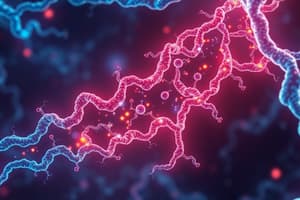Podcast
Questions and Answers
Ligand substitution reactions occur when a ligand bonded to a metal ion is replaced by another __________.
Ligand substitution reactions occur when a ligand bonded to a metal ion is replaced by another __________.
ligand
Cobalt(II) hexaaqua ion reacts with __________ to form a complex.
Cobalt(II) hexaaqua ion reacts with __________ to form a complex.
ammonia
The formation of Cobalt(II) hexaamine occurs after adding excess __________.
The formation of Cobalt(II) hexaamine occurs after adding excess __________.
ammonia
Copper(II) hexaaqua ion reacts with __________ ions, forming a tetrachloro complex.
Copper(II) hexaaqua ion reacts with __________ ions, forming a tetrachloro complex.
The coordination number of Copper(II) decreases from 6 to 4 when it forms a __________ complex.
The coordination number of Copper(II) decreases from 6 to 4 when it forms a __________ complex.
EDTA is an example of a __________ ligand that can bind to a metal ion in a single complex.
EDTA is an example of a __________ ligand that can bind to a metal ion in a single complex.
The __________ effect explains why complexes with multi-dentate ligands are more stable than those with monodentate ligands.
The __________ effect explains why complexes with multi-dentate ligands are more stable than those with monodentate ligands.
Partial ligand substitution results in a complex with four __________ ligands and two water ligands.
Partial ligand substitution results in a complex with four __________ ligands and two water ligands.
Flashcards
Ligand Substitution Reaction
Ligand Substitution Reaction
A reaction where a ligand bound to a metal ion gets replaced by another ligand.
Stronger Coordinate Bonds
Stronger Coordinate Bonds
The new incoming ligand forms stronger bonds with the metal ion, pulling it away from the original ligand.
Ligand Concentration
Ligand Concentration
When a high concentration of the new ligand is present, it forces the equilibrium to favor formation of the new complex.
Multi-dentate Ligands
Multi-dentate Ligands
Signup and view all the flashcards
Chelation Effect
Chelation Effect
Signup and view all the flashcards
Replacing Water with Ammonia
Replacing Water with Ammonia
Signup and view all the flashcards
Partial Ligand Substitution
Partial Ligand Substitution
Signup and view all the flashcards
Coordination Number
Coordination Number
Signup and view all the flashcards
Study Notes
Ligand Substitution Reactions
- Ligand substitution reactions replace a ligand bonded to a metal ion with another ligand.
- This occurs because ligands form stronger coordinate bonds with the metal ion.
- High concentrations of the new ligand force equilibrium towards the new complex formation.
- Focus on water ligands being replaced.
Replacing Water Ligands with Neutral Ligands:
- Example: Cobalt(II) hexaaqua ion (pink) reacts with ammonia to form a complex.
- Step 1: Ammonia acts as a base, removing protons from water ligands, forming Cobalt(II) tetraaquadihydroxide (blue-green).
- Step 2: Excess ammonia leads to complete ligand substitution, forming Cobalt(II) hexaamine (pale yellow).
- Ammonia bonds stronger to Cobalt(II) than water, driving the substitution.
- High ammonia concentration drives reaction to completion.
Replacing Water Ligands with Charged Ligands:
- Example: Copper(II) hexaaqua ion (pale blue) reacts with chloride ions.
- Chloride ions are larger than water ligands, limiting surrounding copper ions.
- This forms Copper(II) tetrachloro complex (yellow) with a reduced coordination number from 6 to 4.
- Coordination number decreases with larger, substituting ligands.
Chelation Effect and Multi-dentate Ligands
- Multi-dentate ligands (multiple donor atoms) bind to a metal ion in a single complex.
- Example: Copper(II) hexaaqua ion reacts with EDTA (hexadentate) to form Copper(II) EDTA complex.
- Reaction is entropically favorable, increasing molecules and complex stability.
- Chelation Effect: Multi-dentate ligand complexes are more stable than monodentate complexes. More coordination sites are occupied, hindering replacement by other ligands.
Partial Ligand Substitution
- Some ligands replace only some water ligands.
- Example: Copper(II) hexaaqua reacts with ammonia to form a complex with four ammonia ligands and two water ligands.
- This distorts the octahedral shape due to varying copper-ligand bond lengths.
Key Concepts to Remember:
- Stability constant (Kstab): Measures complex stability (products/reactants ratio).
- Color Changes: Substitution causes color changes due to altered electronic configurations.
- Coordination Number: Number of ligands attached to a metal ion; changes with substituting ligand size/charge.
- Shape: Complex shapes change with substitutions.
Ammonia's dual role:
- Small amounts of ammonia act as a base, removing protons from water ligands.
- Excess ammonia acts as a ligand, completely substituting water ligands.
Studying That Suits You
Use AI to generate personalized quizzes and flashcards to suit your learning preferences.




